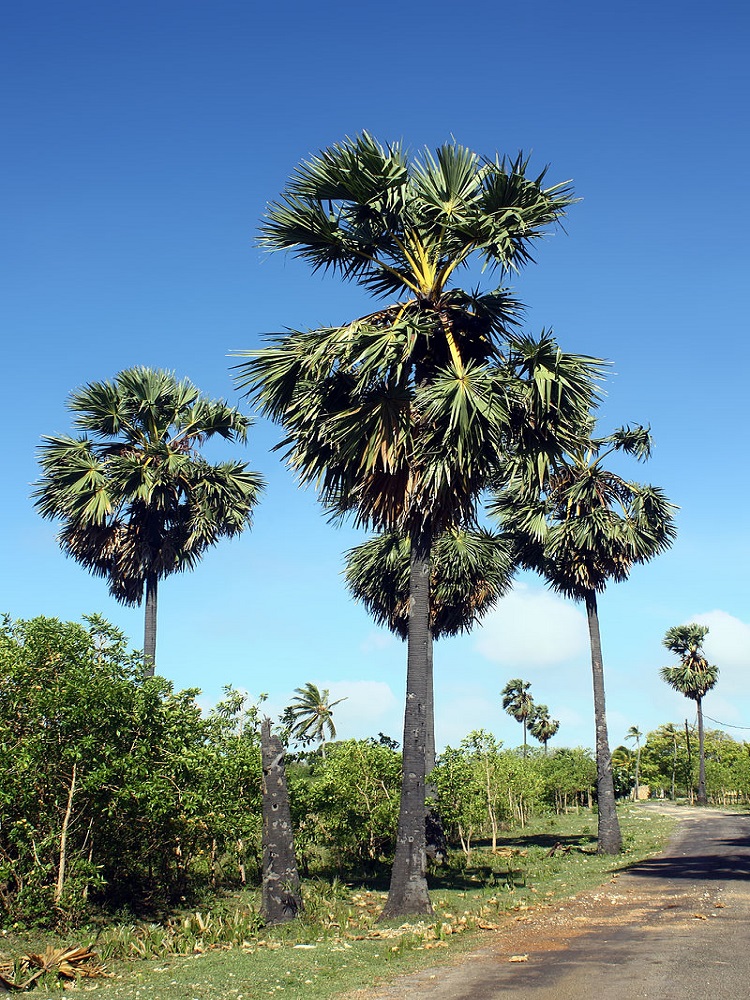Taad - Toddy Palm

Borassus flabellifer
Summary
Scientific Classification
Kingdom: Plantae
Division: Magnoliophyta
Class: Liliopsida
Order: Arecales
Family: Arecaceae
Genus: Borassus
Species: B.flabellifer
Scientific Name: Borassus flabellifer L.
Common Names:
English: Asian Palmyra palm, Toddy palm, Sugar palm, or Cambodian palm.
Hindi: Taad, tal, Trinaraa.
Kannada: Olegari, Taalegari, Taatinimgu.
Marathi: Taad.
Description:
- Habit and Habitat: The palmyra palm is a very tall, dioecious, single-stemmed evergreen palm tree that can eventually reach a height of 30metres. The unbranched stem can be up to 1 metre wide at the base, narrowing to 40 - 50cm at around 4metres and thereafter cylindrical; it is topped by a crown of up to 60 large, stiffly projecting fan-shapedleaves.
- Distribution: found in Bangladesh, Cambodia, China South-Central, India, Jawa, Laos, Lesser Sunda Is., Malaya, Myanmar, Socotra, Sri Lanka, Sulawesi, Thailand, and Vietnam. South and Southeast Asia. Determining the ‘natural’ distribution of Borassus flabellifer is essentially impossible as it is a widely planted crop plant. It is largely restricted to areas with seasonal rainfall and ranges from western India through Indochina to the Lesser Sunda Islands of Indonesia.
- Morphology:
Leaves: Leaves, 40 - 70 per crown, leaves petiole and sheath 150 – 180 cm long; petiole wide at midpoint, robust, bright yellow, margins black with short black erose teeth; lamina radius to 150 cm maximum, dense adaxial and abaxial indumentum on the ribs of some juvenile leaves, leaflets ~62, 4.2 – 9.5 cm wide, apices acute and entire or splitting longitudinally with age, shortest leaflet 13 – 39 cm long, commissural veins 11 – 18 per cm, leaf anatomy isolateral.
Inflorescence and Flowers: Catkin-like, dioecious, Staminate inflorescences branched to two orders, upper subtending branches terminating in 1 – 3 (– 4) rachillae; rachillae green to brown and catkin-like, 23 – 50 cm long and 1.8 – 2.5 cm in diameter, sometimes with a mamilliform apex, rachilla bracts forming pits containing a cincinnus of 4 – 7 flowers. Pistillate inflorescences usually spicate (branched inflorescence pictured in the lectotype), flower-bearing portion 12 – 85 cm long with 5 – 20 flowers arranged spirally. Staminate flowers exserted from pits individually, 0.24 – 0.6 cm long, bracteoles 0.4 – 0.7 × 0.1 – 0.3 cm, calyx 0.3 × 0.15 cm and shallowly divided into three sepals, petal lobes 0.1 × 0.1 cm; stamens 6 with very short filaments, 0.2 × 0.03 cm, anthers, 0.05 × 0.03 cm; pistillode minute. Pollen monosulcate, elliptical, 48 – 95 μm long, aperture 40 – 95 μm long, polar axis 30 – 89 μm long; tectum perforate, sparsely covered with supratectal gemmae. Pistillate flowers 3 × 3 cm; bracteoles large, 2 cm in diam., sepals 1.5 × 2 cm, petals 1 × 1.5 cm.
Fruit: Fruits massive, yellowish black, ovoid and rounded or flattened at the apex; produced inside persistent perianth segments; epicarp coriaceous, mesocarp pulp yellow, pyrenes somewhat bilobed; most pyrenes with one or two external, longitudinal furrows; internal flanges absent.
Seeds: seeds 1-3.
Flowering and fruiting seasons: starts from 12-20 years after germination usually in dry season. - Propagation: Throughseeds.
- Importance:
The fruit, Apical bud, Inflorescence is edible. Sap is used to make jaggery and beverages. Innumerable traditional medicinal uses are known for all parts of the toddy palm. The young plant is said to relieve biliousness, dysentery and gonorrhea. Young roots are anthelmintic and diuretic. A decoction is given in certain respiratory diseases. Dried roots can also be smoked to heal nasal complaints. The ash of the flower is taken to relieve heartburn and enlarged spleen and liver. The bark decoction, with salt, is used as a mouth wash. A charcoal made of the bark serves as a dentifrice. Sap from the flower stalk is prized as a tonic, diuretic, stimulant, laxative and anti-phlegmatic and amoebicide. Sugar made from this sap is said to counteract poisoning and it is prescribed in the treatment of liver disorders. When candied, it is a remedy for coughs and various pulmonary complaints. Fresh toddy, heated to promote fermentation, is bandaged onto all kinds of ulcers. The apical bud, leaf petioles, and dried male flower spikes all have diuretic activity. The pulp of the mature fruit relieves dermatitis. It is also useful as an anti-inflammatory and for dropsy and gastric conditions. Also has potential immuno-suppressive action. Constituents are: gum, fat and albuminoids. The leaves have a wide range of uses, such as thatching for house roots and walls, weaving into baskets, mats and many other items. The top young leaves are made into hats, boxes to store rice, baskets and fans. A fiber obtained from the leaves is used to make string, rope, fencing etc. The fiber obtained from the base of the petioles, or the sheathing leafstalks, is stiff, harsh and wiry. It is used to make brushes etc. Petioles are often can be split into fiber, to be used for weaving and matting. The dried leaflets were at one time used as a paper to record Indian holy texts. The lowest 10 meters of the trunk has a hard and strong wood that is heavy, very durable and very resistant to termites, insect borers and decay fungi. It is good for constructing buildings, bridges etc. The somewhat softer middle part of the stem can be split into boards. The whole trunk can be made into a small boat capable of carrying at least three people. The wood and leaves are used as fuel. The wood can be made into charcoal. - Location: Botanical garden, Main entrance garden.
 Trees of GSS Project supported by Makerspace Belgaum Website concept and designe by
Trees of GSS Project supported by Makerspace Belgaum Website concept and designe by